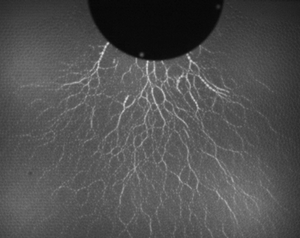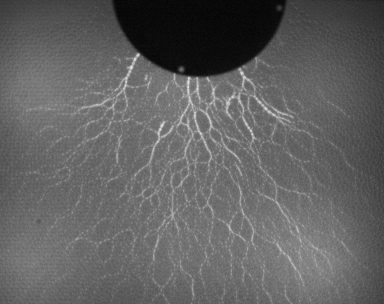Subterranean Sound Waves from Projectile Impact
When a falling rock hurtles into a bed of sand, the grains quickly dissipate its energy and momentum. To learn exactly how the grains absorb the blow, a research team used a high-speed camera to capture the response of grains that light up when squeezed. They report in Physical Review Letters that the impact creates pulses of acoustic waves that travel down into the granular material along networks of connected grains. The results may provide a better understanding of crater formation, as well as granular dynamics in general.
Grains are very effective at absorbing an incoming object’s energy, which is one reason runaway truck ramps often use sand or gravel as their braking medium. Researchers have developed equations to predict macroscopic behavior and the forces involved when granular materials are impacted by meteorites, artillery shells, or other projectiles, but a fundamental understanding is lacking for the grain-scale physics, says Robert Behringer of Duke University in Durham, North Carolina. “No one has really known where the dissipation of energy and momentum occurs.”
Behringer and his colleagues have addressed this question by filming granular impacts at 40,000 frames per second. To obtain an “internal” view, the team confined their grains and projectile between two closely-spaced Plexiglas sheets. The grains were disks, 3 millimeters thick and 4 to 6 millimeters in diameter, made of a photoelastic plastic. When squeezed, this material rotates the polarization of light that passes through it, and Behringer’s team has used such disks in other experiments to image and measure the stresses on individual grains.
When the team dropped larger bronze disks into their granular bed, the grains lit up with a lightning-bolt pattern of so-called “force chains”—networks of grains in contact with one another. Earlier studies of static systems had identified these chains as load-bearing “columns” that would support, for example, the weight of a person standing on sand. But Behringer and his colleagues went beyond this static picture by measuring changes in the force chains over time, with video frames just 25 microseconds apart. Their video data showed that during the slowing of the projectile, stress was transferred down these chains through a steady barrage of millisecond-long acoustic pulses traveling at the granular sound speed (around 300 meters per second). These pulses transmitted the projectile’s energy into the granular bed but died out after traversing 10 to 100 grains, having lost their energy to friction and energy-absorbing collisions among grains.
The random nature of the timing and strength of the pulses led to wide variations on the millisecond scale in the projectile’s deceleration—at some moments braking rapidly and at other times coasting at constant speed. The researchers had expected smoother behavior, since previous observations of projectile impacts had shown no signs of fluctuations, presumably because they had insufficient time resolution [1,2].
The team found a second surprise when they varied the size of the projectiles. Statistical arguments would suggest that larger projectiles would decelerate more smoothly (with less extreme fluctuations) than smaller projectiles because larger ones interact with more force chains. But the fluctuations were about the same for all projectile sizes, which ranged from 10 to 30 times the grain diameter. Part of the explanation, the team speculates, might be that the acoustic pulses are not completely random, independent events, but are correlated in some way, so that their randomness doesn’t easily average out.
Doug Durian of the University of Pennsylvania in Philadelphia finds it surprising that the momentum transfer from the projectile to the grains is intermittent. This sets grains even further apart from other substances, such as fluids, he says. John de Bruyn of the University of Western Ontario in Canada imagines this work having relevance not only in studies of impact craters, but also for landslides and other granular flows. He says the results suggest that theorists have more work to do. In the future, “[any] detailed theoretical understanding of the forces on a body moving in a granular material will have to take the large fluctuations in force into account.”
–Michael Schirber
Michael Schirber is a Corresponding Editor for Physics Magazine based in Lyon, France.
References
- M. A. Ambroso, R. D. Kamien, and D. J. Durian, “Dynamics of Shallow Impact Cratering,” Phys. Rev. E 72, 041305 (2005)
- M. Pica Ciamarra, A. H. Lara, A. T. Lee, D. I. Goldman, I. Vishik, and H. L. Swinney, “Dynamics of Drag and Force Distributions for Projectile Impact in a Granular Medium,” Phys. Rev. Lett. 92, 194301 (2004)
More Information
Shear Forms Force Chains (force chain images from 2008 APS March Meeting)





